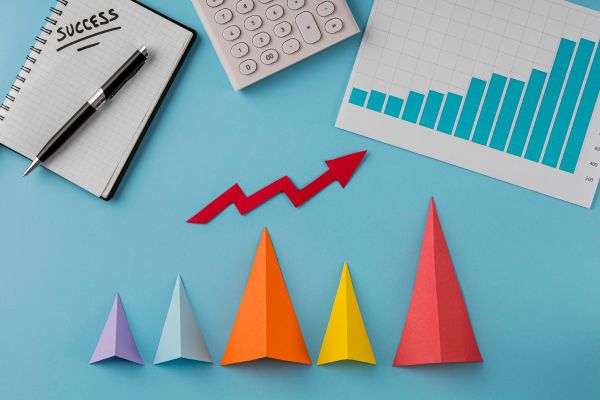As brands continue to invest more in influencer collaborations, the pressure to demonstrate real returns is higher than ever. Yet, influencer marketing ROI remains one of the biggest challenges in the industry today. While engagement and reach are often easy to track, translating those metrics into measurable business outcomes, like sales, leads, or long-term customer value, is where many campaigns fall short.
In this guide, we’ll break down how to:
- ✔ Measure influencer ROI accurately (beyond vanity metrics).
- ✔ Maximize returns with data-driven strategies.
- ✔ Leverage tools and real-world examples to turn influencer partnerships into profit.
Let’s turn those likes into measurable results.

What is Influencer Marketing ROI?
Influencer marketing ROI (Return on Investment) refers to the measurable return from your influencer spend, in other words, how much value your brand gains compared to what you invested. It’s the most straightforward way to assess whether your campaign actually paid off, beyond likes and comments.
If you’re wondering how to calculate influencer marketing ROI, here’s the simple formula:
ROI = (Revenue – Cost) / Cost × 100
Example: Let’s say you spent $10,000 on a campaign, and it generated $50,000 in sales.
Your ROI would be: ($50,000 – $10,000) / $10,000 × 100 = 400% ROI
This means you earned four times what you spent – clear, measurable success. While ROI isn’t always purely about revenue, this formula provides a solid baseline for evaluating performance.
If calculating ROI feels overwhelming, Hypefy’s free ROI calculator can help simplify the process.
Real-world example: Allbirds, the eco-conscious fashion brand, implemented an always-on influencer strategy that drove remarkable results. According to Acceleration Partners, this approach led to a 371% year-over-year increase in revenue and a 410% increase in conversions. By consistently collaborating with influencers across various tiers, Allbirds effectively built trust, scaled reach, and tracked measurable performance over time.
How to attribute revenue accurately?
There are several practical ways brands can pinpoint which influencer efforts are driving traffic and sales, making attribution clearer and more measurable:
- Promo Codes/Discount Links – Give each influencer a unique discount code to directly attribute sales (e.g., “FALL20” for 20% off).
- Affiliate Links – Use tools like RewardStyle or Impact to track purchases and clicks at the individual level.
- UTM Parameters – Add trackable UTM codes to links influencers share to capture traffic and conversions in Google Analytics.
- Influencer-Specific Landing Pages (e.g., “brand.com/influencer-name”).
By setting up proper attribution, you’ll know exactly which influencers are driving real results and which aren’t.
Why Measure Influencer Marketing ROI?
Measuring influencer marketing ROI isn’t just about proving that your campaign worked, it’s about understanding how and why it performed the way it did. Without clear measurement, it’s impossible to know whether your investment is truly driving business growth or simply generating surface-level engagement.
Here’s why tracking ROI matters:
- Justify your spend: With influencer budgets growing, leadership teams want clear proof that these investments deliver real returns, not just likes or comments. It holds your campaigns and your spending accountable to real outcomes, like sales, leads, or customer growth.
- Optimize future campaigns: By analyzing results, you can identify which influencers, content types, or platforms performed best and use those insights to improve your next campaign. Solid ROI data helps you justify future investments, allocate your marketing budget more effectively, and focus on what’s working.
- Compare performance across channels: Measuring ROI helps you evaluate influencer marketing against other digital marketing efforts such as paid ads, email marketing, or SEO. By tracking ROI, you can spot which influencers, content styles, or platforms perform best, helping you refine your strategy over time.
- Business impact: Ultimately, measuring ROI ties influencer marketing back to broader business goals like revenue growth, customer retention, and brand loyalty.
In short, if you want influencer marketing to be seen as a serious revenue driver and not just a branding exercise, measuring ROI is non-negotiable.
What actually works in influencer marketing today? Find out in Influencer Marketing Strategies: 7 Data-Backed Tactics for 2025.
What is the Average ROI for Influencer Marketing?
On average, brands are seeing strong returns from influencer marketing efforts. According to industry studies, the typical influencer marketing ROI is around $5.78 earned for every $1 spent. Some high-performing campaigns, especially those with the right influencer-brand alignment and solid tracking, can see even higher returns.
Of course, ROI can vary widely depending on factors like:
- Industry (e.g., beauty and fashion typically outperform more niche sectors)
- Campaign type (awareness vs. direct sales)
- Influencer tier (micro-influencers often deliver better engagement and cost-efficiency)
- Target audience (younger, digital-native audiences are more responsive to influencer content)
Here’s what the data says:
1. Industry Benchmarks
- Fashion & Beauty: 5:1–10:1 ROI (For every 1spent, 5–$10 earned)
- Health & Wellness: 4:1–8:1
- Tech & SaaS: 3:1–6:1 (Lower due to longer sales cycles)
- Food & Beverage: 6:1–12:1 (Driven by impulse purchases)
2. Influencer Tier Matters
- Nano-influencers (1K–10K followers): 11.3% avg. engagement rate → with the highest ROI potential
- Micro-influencers (10K–100K): 8.5% engagement → which shows the best balance of reach & ROI
- Macro/Mega (100K+): Lower ROI but broader awareness
3. Platform Differences
- TikTok: 4.50 earned per 1 spent (Best for Gen Z)
- Instagram: 3.20 per 1 spent (Strongest for e-commerce)
- YouTube: 2.80 per 1 spent (Higher production costs)
It’s important to remember that while industry averages provide a useful benchmark, your ROI depends on how well you plan, execute, and measure your influencer marketing campaigns. Proper tracking, clear goals, and smart influencer selection are what turn average results into outstanding ones.

Key Metrics for Measuring Influencer Marketing ROI
To truly understand the ROI of influencer marketing, you need to track more than just likes and comments. Track these 5 essential metrics, beyond just revenue:
1. Conversion Rate (Promo Codes, Affiliate Links) – Direct Impact
What it measures: Conversion rate measures how many people took a desired action, like making a purchase, after interacting with an influencer’s content.
How to track: Using promo codes (e.g., “INFLUENCER20” for 20% off) or affiliate links assigned to specific influencers makes it easy to attribute sales directly. This gives you clear visibility into which influencers are driving real revenue, not just awareness.
Tip: Track promo code redemptions and affiliate link clicks separately for deeper insights.
2. Customer Acquisition Cost (CAC) (Efficiency Check)
What it measures: CAC tells you how much it costs to acquire a new customer through influencer marketing compared to other channels like paid search, email marketing, or paid social ads. Lower CAC usually means more efficient spending. If influencer CAC is cheaper, or generates higher LTV customers, it’s a strong argument to expand your influencer budget.
Formula: CAC = Total Campaign Spend ÷ Number of New Customers
3. Engagement Rate (Quality Over Vanity Metrics)
What it measures: Engagement rate (likes, comments, shares) shows how much an audience interacts with an influencer’s content. But not all engagement is equal, focus on meaningful interactions rather than surface-level metrics. For example, a smaller influencer with real conversations in the comments often drives better ROI than a mega-influencer with millions of passive likes.
Formula: Engagement Rate = (Total Engagements ÷ Total Followers) × 100
Tip: Watch for authentic, relevant comments, not just emojis or generic phrases.
4. Brand Lift (Surveys, Search Volume) – Indirect Impact
What it measures: Changes in brand perception/awareness post-campaign. Influencer campaigns don’t always drive immediate sales, and that’s okay. Sometimes, the biggest win is brand lift: increases in brand awareness, consideration, or preference.
How to track:
- Surveys (asking audiences if they recall the influencer partnership, e.g., “Did you hear about us from [influencer]?”)
- Search volume spikes (Google Trends, branded keyword traffic)
- Social mentions (Brandwatch, Mention)
5. Lifetime Value (LTV) of Influencer-Acquired Customers (Long-Term Payoff)
What it measures: A customer acquired through influencer marketing may not just buy once, they may become a long-term, loyal buyer. Tracking Lifetime Value (LTV) helps you see the total revenue generated by these customers over time, not just from the initial purchase.
Formula: LTV = Average Order Value × Purchase Frequency × Customer Lifespan
If influencer-acquired customers have a higher LTV compared to customers from other channels, it means your influencer program is contributing even more value than you might initially measure.
Summary Tip: Don’t rely on just one metric. A complete view of influencer marketing ROI comes from looking at both direct sales (conversion rate, CAC) and long-term brand impact (brand lift, LTV). The strongest campaigns balance both.
Strategies to Maximize Influencer Marketing ROI
Maximizing influencer marketing ROI doesn’t happen by chance – it takes careful planning, smart execution, and ongoing optimization. Here are key strategies to help you get the most out of every campaign:
1. Select the Right Influencers (Not Just the Biggest)
Instead of focusing only on follower count, prioritize influencers whose audience closely matches your target market. Look for authentic engagement, aligned values, and past campaign performance. Micro-influencers and niche creators often drive better ROI than big names with broad audiences.
Use influencer discovery platforms to filter by audience demographics, engagement rates, and content relevance.
If you’re looking to launch or refine your influencer campaigns, don’t miss our Influencer Marketing Guide: Strategies for Effective Campaigns. It covers everything from planning and discovery to execution and optimization.
2. Set Clear Goals and KPIs
Define what success looks like before the campaign starts. Whether it’s direct sales, lead generation, brand lift, or social engagement, having clear goals allows you to select the right influencers, craft the right messaging, and measure results accurately.
3. Provide Creative Freedom (Within Guidelines)
Influencers know how to connect with their audiences better than anyone else. Give them space to create authentic content that fits their style, while providing clear brand guidelines. Campaigns that feel forced or overly scripted usually underperform.
4. Leverage Evergreen Campaigns
- Avoid one-off posts: Work with influencers on series or long-term partnerships to build trust.
- Example: Glossier, a direct-to-consumer beauty brand, has built its success on influencer marketing. By partnering with beauty influencers and utilizing user-generated content, Glossier has created a loyal customer base. Their “rep” program, where influential customers can earn rewards by promoting the brand, has contributed to both acquisition and retention.
- Idea: Create a branded hashtag (e.g., #MyBrandJourney) to track ongoing UGC.
5. Optimize for the Platform’s Algorithm
Repurpose influencer content across your brand’s channels – social media, email marketing, paid ads, and even your website. Maximizing content usage increases the value of each piece of influencer-created content and stretches your investment further.
- Instagram Reels/TikTok: Short, trending hooks (first 3 seconds matter).
- YouTube: Longer, tutorial-style videos (ideal for high-AOV products).
- Pinterest: Static posts with keyword-rich descriptions.
6. Focus on Long-Term Partnerships
One-off posts rarely deliver the strongest returns. Building ongoing relationships with influencers leads to higher trust, better integration with your brand, and stronger, more natural advocacy over time, all of which improve ROI.
7. Test and Learn
No campaign is perfect from the start. Use A/B testing for content formats, promo offers, and posting times to see what resonates best. Continually optimize based on real campaign data rather than assumptions.

Common Influencer Marketing ROI Mistakes (And How to Fix Them)
Even well-planned influencer campaigns can underperform if key missteps happen. Here are some of the most common mistakes brands make, and how to avoid them:
1. Choosing Influencers by Follower Count Alone
It’s tempting to think bigger is better, but selecting influencers just because they have a large audience often backfires. High follower counts don’t guarantee engagement or conversions. Always prioritize relevance, authenticity, and engagement rate over pure size.
2. Setting Vague or No Campaign Goals
Without clear goals, it’s impossible to measure success, or even know what you’re aiming for. Campaigns need defined objectives from the start, whether it’s boosting website traffic, generating sales, or increasing brand awareness.
3. Lack of Proper Tracking
Skipping promo codes, UTM links, or affiliate tracking makes it nearly impossible to attribute results. Without solid tracking in place, you can’t accurately measure ROI or identify your top-performing influencers.
4. Overcontrolling Influencer Creativity
Micromanaging influencers or forcing them to stick rigidly to brand scripts can make content feel unnatural. Followers can sense when a post is inauthentic, which damages trust, and kills conversion rates. Give influencers room to be themselves while staying aligned with your brand.
5. Ignoring Post-Campaign Analysis
Many brands launch a campaign and move on without a deep dive into performance data. Without proper analysis, you miss valuable insights about what worked (and what didn’t), making it harder to improve future ROI.
How Hypefy Automates Influencer Marketing ROI Tracking
Measuring influencer marketing ROI can be complex, but Hypefy simplifies the process through AI-powered automation. You can automate attribution, payments, and performance analysis in one platform. Here’s how it works:
- AI-Driven Influencer Selection: Hypefy’s AI analyzes your campaign goals, target audience, and budget to recommend influencers whose followers align with your objectives. By sourcing creators directly from platforms like Instagram and TikTok, Hypefy ensures authentic partnerships that resonate with your intended audience.
- Automated Campaign Management: Once influencers are selected, Hypefy automates outreach, content approvals, and scheduling. This reduces manual workload and accelerates campaign deployment, allowing brands to focus on strategy rather than logistics.
- Real-Time Performance Tracking: Hypefy provides a dashboard that displays real-time metrics such as reach, engagement, and cost. This enables brands to monitor campaign performance continuously and make data-driven adjustments as needed.
- Comprehensive ROI Reporting: At the conclusion of a campaign, Hypefy generates detailed reports that outline key performance indicators and ROI calculations. These insights help brands understand the effectiveness of their influencer marketing efforts and inform future strategies.
By integrating Hypefy into your influencer marketing strategy, you can automate ROI tracking, reduce manual tasks, and gain valuable insights to optimize your campaigns
Case Study: NIVEA’s Success with Hypefy
NIVEA partnered with Hypefy to streamline influencer collaborations in Croatia during one specific campaign. By targeting young adults with authentic, gender-neutral content, they achieved:
- Reach: 455,000 people
- Engagement: 36,800 interactions
- Clicks: 1,500 to product links



